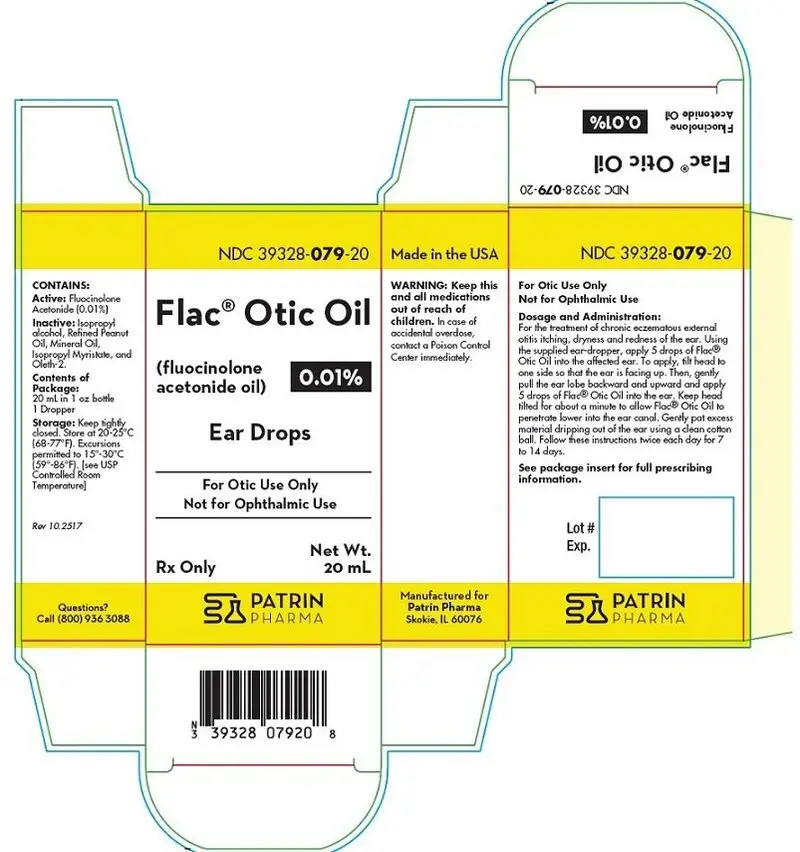Drug Detail:Flac otic oil (Fluocinolone otic [ floo-oh-sin-oh-lone ])
Drug Class: Otic steroids
Clinical Studies
Efficacy in a placebo-controlled study for the treatment of chronic eczematous external otitis on 154 patients (adults and children 2 years of age and older) treated with five drops per ear of Fluocinolone Acetonide Oil, 0.01% twice daily, after 7 days of treatment, showed Fluocinolone Acetonide Oil, 0.01% to be superior to placebo in clearing the signs and symptoms of eczematous external otitis.
Clinical safety studies were conducted on the same formulation of Fluocinolone Acetonide Oil, 0.01%, marketed as Fluocinolone Acetonide 0.01% Topical Oil. Open-label safety studies on 33 children (20 subjects ages 2 to 6 years, 13 subjects ages 7 to 12 years) with moderate to severe stable atopic dermatitis, and baseline body surface area involvement greater than 75% in 18 patients, and 50% to 75% in 15 patients, were treated with Fluocinolone Acetonide 0.01% Topical Oil twice daily for 41 weeks. Morning pre-stimulation cortisol level and post-Cortrosyn stimulation cortisol level were obtained in each subject at the beginning of the trial and at the end of 4 weeks of treatment. At the end of treatment, 4 out of 18 subjects aged 2 to 5 years showed low pre-stimulation cortisol levels (3.2 to 6.6µg/dL; normal: cortisol > 7µg/dL) but all had normal responses to 0.25 mg of Cortrosyn stimulation (cortisol > 18µg/dL).
A clinical study was conducted to assess the safety of Fluocinolone Acetonide 0.01% Topical Oil, which contains refined peanut oil, on subjects with known peanut allergies. The study enrolled 13 patients with atopic dermatitis, 6 to 17 years of age. Of the 13 patients, 9 were Radioallergosorbent Test (RAST) positive to peanuts and 4 had no peanut sensitivity (controls). The study evaluated the responses to both prick test and patch test utilizing peanut oil NF, Fluocinolone Acetonide 0.01% Topical Oil and histamine/saline controls on the 13 individuals. These subjects were also treated with Fluocinolone Acetonide 0.01% Topical Oil twice daily for 7 days. Prick test and patch test results for all 13 patients were negative to Fluocinolone Acetonide 0.01% Topical Oil and the refined peanut oil. One of the 9 peanut-sensitive patients experienced an exacerbation of atopic dermatitis after 5 days of Fluocinolone Acetonide 0.01% Topical Oil use. Importantly, the bulk peanut oil NF, used in Fluocinolone Acetonide 0.01% Topical Oil is heated at 475° F for at least 15 minutes, which should provide for adequate decomposition of allergenic proteins.
Precautions
Pediatric Use
Fluocinolone acetonide oil, 0.01% may be used twice daily for up to 2 weeks in pediatric patients 2 years of age and older with chronic eczematous external otitis.
Fluocinolone acetonide oil, 0.01% is not recommended for use on the face (See ADVERSE REACTIONS section).
Because of a higher ratio of skin surface area to body mass, children are at a greater risk than adults of HPA-axis-suppression when they are treated with topical corticosteroids. They are therefore also at greater risk of glucocorticosteroid insufficiency after withdrawal of treatment and of Cushing's syndrome while on treatment. Adverse effects including striae have been reported with inappropriate use of topical corticosteroids in infants and children. (See PRECAUTIONS).
HPA axis suppression, Cushing's syndrome, and intracranial hypertension have been reported in children receiving topical corticosteroids. Children may be more susceptible to systemic toxicity from equivalent doses due to their larger skin surface to body mass ratios. Manifestations of adrenal suppression in children include linear growth retardation, delayed weight gain, low plasma cortisol levels, and absence of response to ACTH stimulation. Manifestations of intracranial hypertension include bulging fontanelles, headaches, and bilateral papilledema.
Fluocinolone acetonide oil, 0.01% is formulated with 48% refined peanut oil NF. Physicians should use caution in prescribing fluocinolone acetonide oil, 0.01% for peanut-sensitive individuals.
Adverse Reactions/Side Effects
The following local adverse reactions have been reported infrequently with topical corticosteroids. They may occur more frequently with the use of occlusive dressings, especially with higher potency corticosteroids. These reactions are listed in an approximate decreasing order of occurrence: burning, itching, irritation, dryness, folliculitis, acneiform eruptions, hypopigmentation, perioral dermatitis, allergic contact dermatitis, secondary infection, skin atrophy, striae, and miliaria. One peanut sensitive child experienced a flare of his atopic dermatitis after 5 days of twice daily treatment with fluocinolone acetonide oil, 0.01%.
| FLAC OTIC OIL
fluocinolone acetonide oil |
||||||||||||||||||||
|
||||||||||||||||||||
|
||||||||||||||||||||
|
||||||||||||||||||||
|
||||||||||||||||||||
|
||||||||||||||||||||
|
||||||||||||||||||||
| Labeler - Patrin Pharma, Inc. (806841677) |
| Registrant - Patrin Pharma, Inc. (806841677) |






